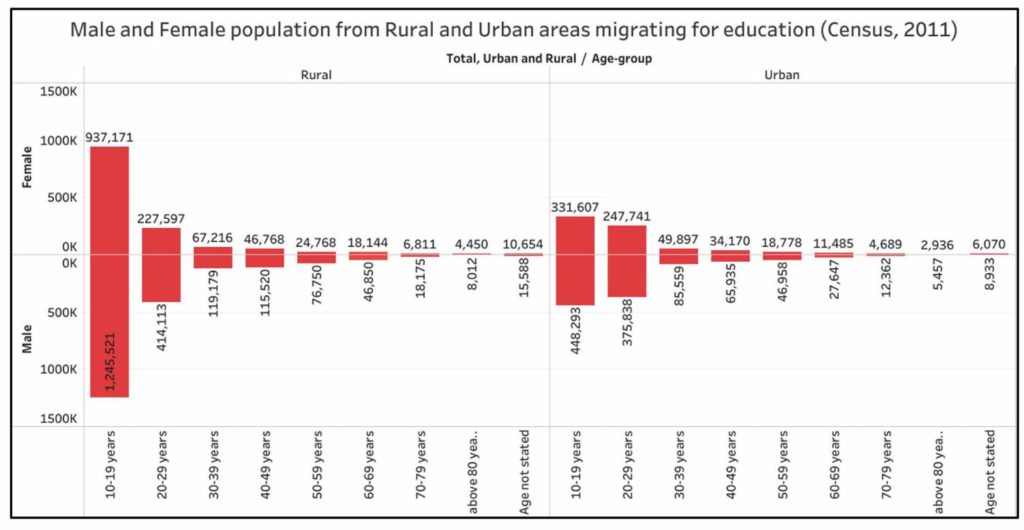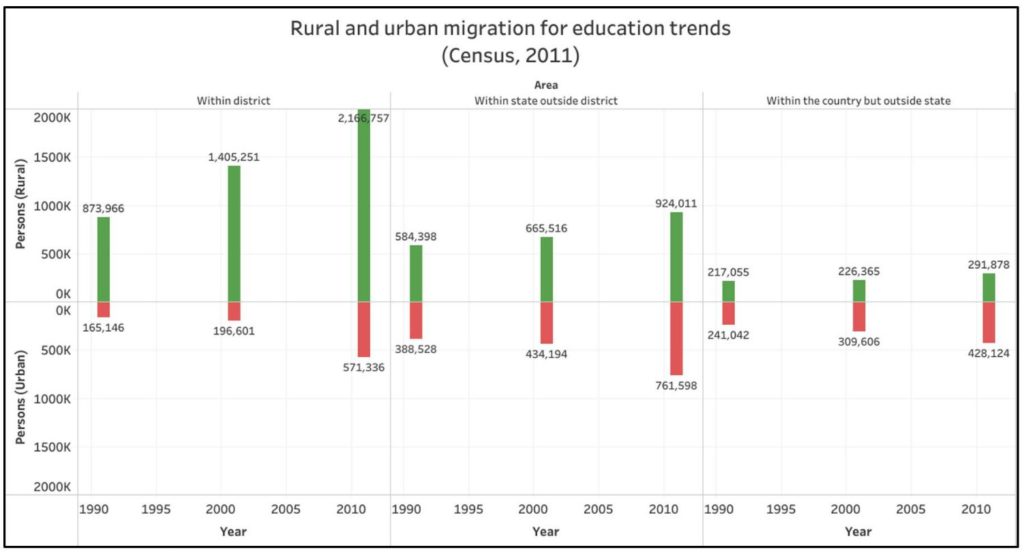[orc]The migration data from the 2011 census was recently released by the Census office. According to the data, 1 out of every 100 migrants in India move in search of education.
Migration involves the movement of people across political & geographical boundaries. There could be multiple reasons for migration ranging from employment, quality education opportunities, business related reasons, marriage and many other socio, economic, cultural and even political reasons. Often, it is the youth that tend to migrate to new cities for education and employment opportunities hoping to lead a better life. The Census office recently released the migration related data that have a whole lot of information on migration patterns in India, reasons and the people who are migrating. As per the census data, in the case of women, marriage is the most prominent reason for migration in India. In fact, Marriages alone account for 46.3% of the total migration that takes place in the country. A total of 45.57 crore people migrated in India for various reasons as per the 2011 census.
How does the Census count Migration?
The Census 2011 included a question on ‘Place of Last Residence’. This question was recorded only for those persons who had come to a village/town of enumeration from elsewhere. The place of last residence refers to the present name of the village/town from where the person has migrated to the place of enumeration. If a person is living at the place of enumeration since her/his birth and never gone out except on temporary visit to their relatives, pilgrimage, tour etc., she/he was considered to be a non-migrant by place of last residence. Even if a person was born at the place of enumeration but shifted to another village/town for any reason say study/work etc., and subsequently had returned to the place of enumeration, she/he was considered as a migrant by place of last residence. In other words, those who moved out at least once for any of the reasons like work/employment, business, education, marriage, moved after birth, moved with household etc. were considered as migrants.
1 out of every 100 migrants move out for Education
As per census 2011, a total of 32,96,340 men and 21,61,216 women have migrated in India because of education. Men constitute 60.4% and Women 39.6% of these migrants who did so for the purpose of education. Of those who migrate for education, 60.4% and 60.5% from rural and urban areas respectively are males and the rest constitute females. Together they constitute 1.2% of the total migrants in India. The 2011 Census data shows that, for education, the largest migrant state is Andhra Pradesh (including Telangana) which has 9,33,354 migrants or more than 16% of the total migrants in this category. But of these, a total of 9,06,123 migrated from within the state which is a whopping 97% of the total migration. This could be due to the prevalent culture of corporate colleges for Intermediate education. Following this is Maharashtra with 7,75,062 who migrated for education. Of these, a total of 6,48,596 migrated from within state, which is around 84% of the total migrants in the state with education as the reason. Karnataka, Tamil Nadu and Uttar Pradesh follow this in the same order. Let’s take a deeper look into the numbers from rural and urban areas.
Those in the age group of 10-29 constitute 81.6% of those who have migrated for education
From both urban and rural areas, those in the age group 10-19 years make up a large portion of the total migrants. In the case of education as a reason for migration, they account for 57.5% since this is prime age for education. On the other hand, those of the age group 20-29 years account for 24.1%. Since most people stop education by the age of 30 and since there is a lesser probability of people working in the place of their education, the proportion of those above 30 who migrated for education is negligible compared to the 10-29 age group. Of the people above the age of 40 years who migrated for education, the proportion of female migrants is less than half of the male migrants. It is heartening to note that the number of females leaving their houses seeking better education has increased.
Percentage of Females moving for education is increasing
In the age group of 10-29 years, females account for 41.3% of the total migrants who moved for education. Further, it can also be observed that 42.93% of those in the age group of 10-19 years and 35.5% in the next age group of 20-29 years from rural areas are females. Similarly, in urban areas, 42.5% and 39.7% of those in the age groups of 10-19 and 20-29 years respectively were females. In the age group of 30-60 years, females account for only 16.3% of those who moved for this reason. Since the life expectancy at birth 10 years ago was around 60, the numbers for the 60+ age group may not reflect the actual state of affairs in terms of the exact number of people who left their houses for education. In addition to this, there are many other social factors such as employment, marriage, business, etc. which would affect these numbers.

Migration within district for education has increased by 163.5% from 1991
The number of people migrating from rural and urban areas is shown in the following chart. From the chart, it is evident that the number of people migrating from rural areas is much higher than those migrating from urban areas. The tendency of the students in rural areas is to migrate within the same district for education. We can also see that every decade, there is an increase in the number of students migrating, at a much greater pace than the population growth. It can also be observed that out of those migrating within the same district, in 2011, 79% of the students were from rural areas. An approximate increase of 71% is seen in migration within the district compared to the year 2001. This increase is around 163.5% when compared to the year 1991. In terms of migration numbers within the state, the year 2011 has witnessed an increase of 53% in the number of students migrating as compared to the previous decade. In the case of inter-state migration, the percentage increase among rural population was only 28.9% in 2011 and 4.3% in 2001 compared to the previous census. At the same time, in urban areas, the numbers increased by over 77.6% in the two decades.

Uneven distribution of Educational Infrastructure could be leading to high migration
India still has a long way to go to achieve 100% literacy. The uneven distribution of population & educational infrastructure coupled with lack of access to quality education is one major driver of migration in search of education. Flow of human capital to other places prevails because of the same.
Within the state, students migrate to different districts since the quality of education and the facilities available is believed to be better elsewhere, especially true in the case of urban centers. Similarly, migration, though at a smaller scale can be seen across states and also outside India. Privatisation of education, increased cost for higher education, concentration of educational infrastructure in certain pockets and the availability of opportunities influence the prevalent trends. Reputation of institutes, scholarships, security and future options are also some of the factors that people look into before migrating in search of better education.
Featured Image:Migration in India for Education


